Ghormeh Sabzi always takes me back to my childhood weekends. The delicious aroma of this Persian herb stew filled our home as my mom would start cooking it early in the morning. I remember waking up to the mouthwatering scent of fresh herbs, simmering meat, and dried limes—a smell that meant something special was waiting for lunch. Ghormeh Sabzi isn’t just food; it’s a taste of tradition, comfort, and love. Served with fluffy saffron rice, often paired with a crispy Persian tahdig (the golden crust at the bottom of the pot), and a refreshing Shirazi salad, it’s the kind of meal that stays in your heart forever and makes you feel at home with every bite.
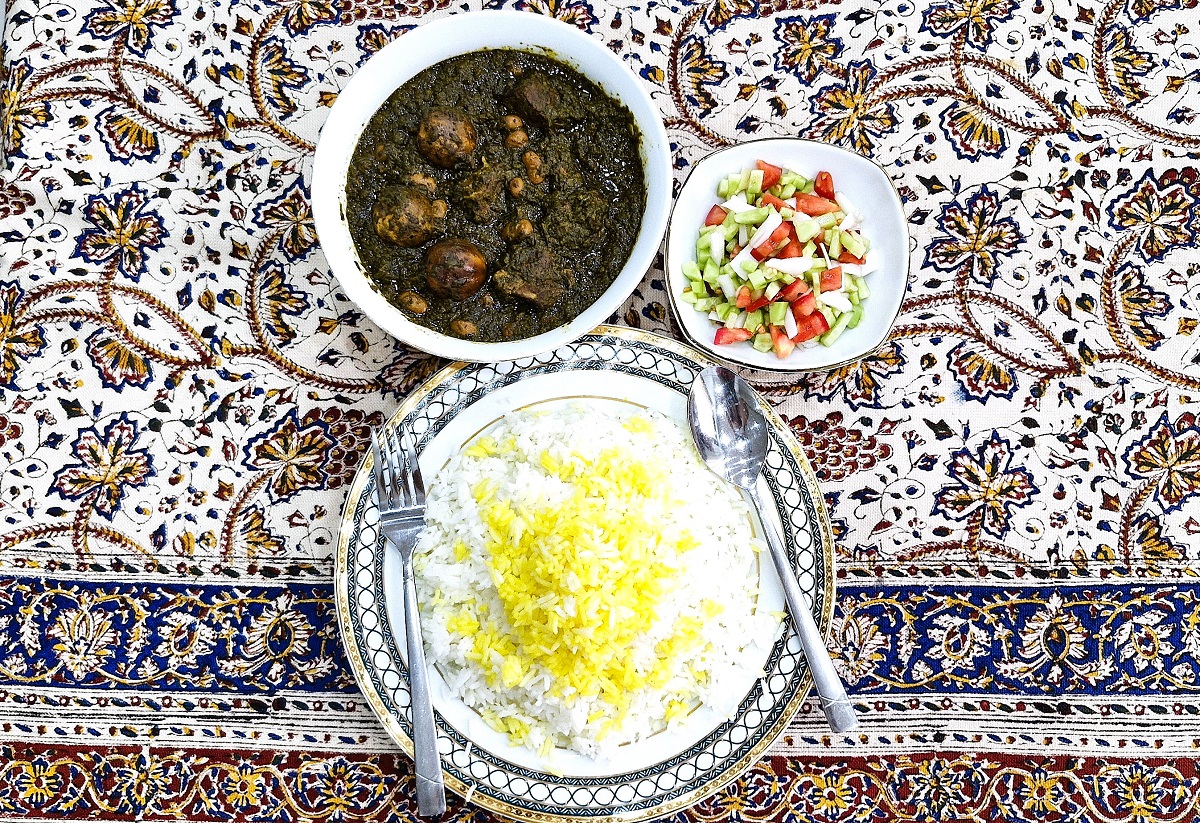
What Is Ghormeh Sabzi?
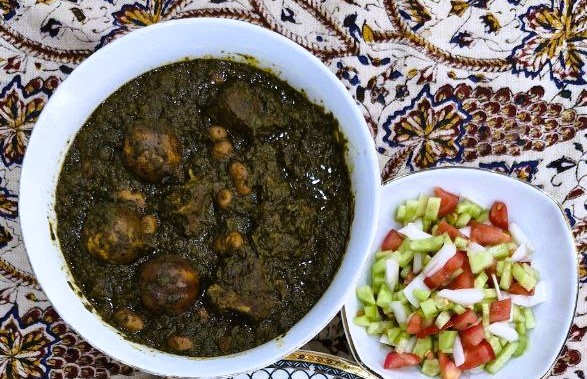
Ghormeh Sabzi is one of the most iconic and beloved stews in Persian cuisine. It’s made with fresh herbs, tender chunks of meat, dried limes, and beans—usually red kidney beans or pinto beans.
This traditional dish holds a special place on every Persian table and is deeply tied to family memories. In many Iranian households, children proudly say their mom makes the best Ghormeh Sabzi ever! It’s more than just a meal—it’s a taste of home and tradition.
How To Make Ghormeh Sabzi (Persian Herb Stew)?
To make a delicious Ghormeh Sabzi, soak the beans the night before. Then, sauté the onion and meat. Add the beans and water, and cook. Add the fried herbs and dried limes, and finally, adjust the flavor of the Ghormeh Sabzi with salt, red pepper, black pepper, and curry powder.
Step 1: Preparing the Pinto Beans
Soak the pinto beans overnight and change the water several times to remove any gas and make them cook more easily. Then, place the beans in a pot, add boiling water, and set the pot on low heat to cook thoroughly.
Step 2: Washing and Chopping the Herbs
Clean the herbs and wash them thoroughly with disinfectant. Once fully dried, finely chop them with a sharp knife. The herbs for Ghormeh Sabzi should be chopped finer than the other ingredients. Next, sauté the herbs in a pan over low heat. When the water from the herbs has evaporated to some extent, add oil and continue frying the herbs until they are fully cooked and crispy.
Step 3: Frying the Herbs for Ghormeh Sabzi
In a suitable pot, chop two onions and sauté them with two full tablespoons of solid oil until the onions change color. Then, it’s time for the meat. Beef or lamb, preferably from the shoulder and slightly bone-in, is the best choice. Cut the meat and add it to the onions, allowing it to brown well.
Once the meat is fully browned, add one teaspoon of turmeric, curry powder, black pepper, and red pepper, and sauté them together until the spices are well mixed with the meat. When the meat turns golden, add the sautéed herbs to the mixture. At this stage, pour in two full cups of boiling water. Make sure not to use lukewarm or cold water, as the temperature difference can cause the meat to become tough. For a richer stew, you can use lamb or beef bone broth. If bone broth isn’t available, ready-made meat broth can be a suitable alternative.
Now, cover the pot and let the stew simmer gently on low heat, allowing it to cook slowly and thoroughly.
Step 4: Cooking the Onions and Meat
After the herbs and meat are cooked, add the cooked beans to the stew. Be sure to include the cooking liquid from the beans as well. Then, lower the heat to a simmer, allowing the stew to cook slowly. At this stage, add the required amount of salt and other spices to taste.
Step 5: Simmering the Stew with Beans and Dried Limes
Wash three dried limes and puncture them in the center. Add them to the stew about 30 minutes before turning off the heat, allowing the limes to release their full aroma into the stew. The dried limes absorb the excess oil and give your Ghormeh Sabzi a unique flavor. Finally, add a little sour grape juice to enhance the taste.
Step 6: Final Touch with Flour and Fenugreek
In a pan, sauté one tablespoon of wheat flour with a bit of oil until the flour turns slightly darker. Then, add dried fenugreek and sauté briefly. Add this mixture to the Ghormeh Sabzi to give it a glossy texture and enhance its flavor. I learned this trick from my mom.
Once the stew is cooked, you can enjoy your meal with saffron rice and Shirazi salad, sharing it with your family.
What Herbs Go In Ghormeh Sabzi (Persian Herb Stew)?
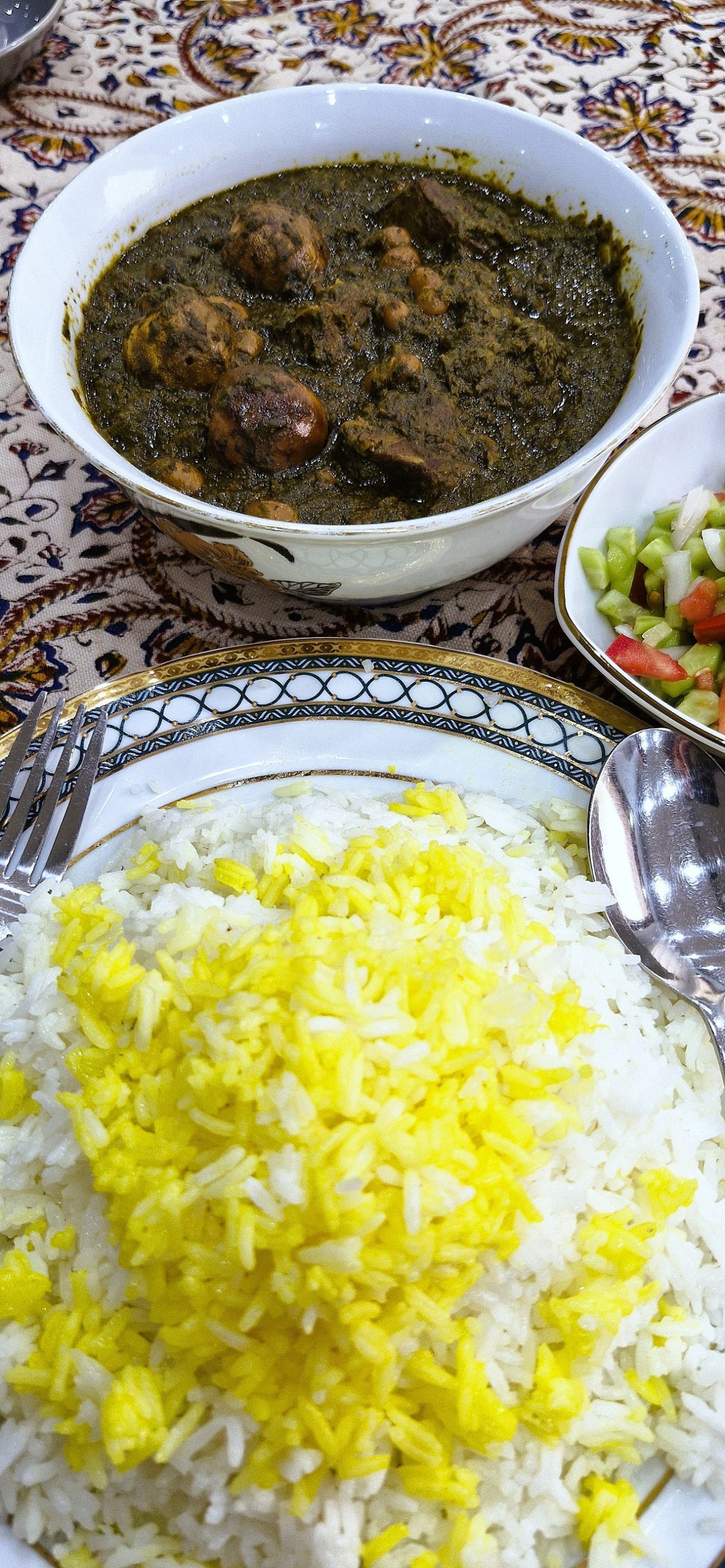
The most important main ingredient for making Ghormeh Sabzi is the herb mix used in the dish, and all the aroma of Ghormeh Sabzi comes from these herbs. For this reason, one of the most common questions when preparing Ghormeh Sabzi is: What are the herbs used in Ghormeh Sabzi?
The Ghormeh Sabzi herbs in Tehran consist of a mix of leek, fenugreek, and parsley.
The Ghormeh Sabzi herbs in southern Iran include a combination of leek, parsley, cilantro, dill, spinach or beet leaves (or both in equal amounts), fenugreek, and green garlic. In the Khuzestan version of this Ghormeh Sabzi, the amounts of dill, fenugreek, and green garlic are about one-quarter, and the amounts of cilantro and spinach are half of the leek and parsley.
The Ghormeh Sabzi herbs in northern Iran consist of a combination of leek, cilantro, parsley, and fenugreek. In this mix, the amounts of leek, cilantro, and parsley are equal, and the amount of fenugreek is one-third of the leek, cilantro, and parsley.
What Beans are in Ghormeh Sabzi?
Why Choosing the Right Bean for Ghormeh Sabzi Matters
If there’s one dish every Iranian has a soft spot for, it’s Ghormeh Sabzi! One of the key ingredients that really affects the flavor, texture, and even the look of this beloved stew is beans. But here’s the thing — the type of bean you use totally depends on your taste. Some people go classic with red kidney beans, others like to switch it up with pinto beans or even black-eyed peas. Let’s break down the most popular choices and see what makes each one special.
1. Red Kidney Beans – The Classic Favorite
What they’re like
- Medium-sized with a deep red color
- Mild flavor that blends well with other ingredients
- Hold their shape well even after long cooking
Why they wor
Red kidney beans are the traditional go-to for Ghormeh Sabzi in most Iranian households. They’ve got a neutral, pleasant taste and a firm texture that pairs perfectly with the rich herbs and tender meat. Plus, that red color adds a nice pop to the dish!
Pro tip
To reduce bloating, soak them overnight and change the water a few times before cooking.
2. Pinto Beans – A Tasty Twist
What they’re like
- Creamy-colored with specks of brown
- Rich, creamy flavor
- Great for adding thickness and depth to the stew
Why they work
Pinto beans are an awesome alternative if you want your Ghormeh Sabzi to be a little thicker and more flavorful. Some families (like mine!) always use pinto beans and love the richer, heartier vibe they bring to the dish.
Pro tip
If you’re into thick, comforting stews, give pinto beans a try — they might become your new favorite!
3. Black-Eyed Peas – A Regional Twist
What they’re like
- Small and light-colored with a little black dot in the center
- Mild, delicate flavor
- Quicker to cook than other beans
Why they work
In southern parts of Iran, some people make Ghormeh Sabzi with black-eyed peas. They give the stew a lighter feel, which is great if you’re watching your fat intake or just prefer something a bit less heavy.
Pro tip:
Since black-eyed peas cook fast and have a soft texture, try using a bit less than usual so your stew doesn’t turn out too watery.
How long does Ghormeh Sabzi last in the fridge?
Ghormeh Sabzi tastes even better the next day! You can refrigerate it for up to 4 days or freeze for up to 2 months. Reheat gently on the stove or in the microwave.
Tips for Perfect Ghormeh Sabzi
- Add salt only after the meat is fully cooked, as adding it earlier can slow down the cooking process. If the stew reduces too much, you can add some boiling water.
- For the herb mix in Ghormeh Sabzi, the amount of leek and parsley should be twice as much as the other herbs. For 700 grams of herbs, follow this ratio: Leek: 200 grams, Parsley: 200 grams, Coriander: 100 grams , Spinach or beet greens: 100 grams, Dill: 50 grams, Fenugreek: 50 grams.
- If you don’t have spinach, you can substitute it with beet greens.
- In the herb mixture for stews, the amount of dill and fenugreek should be less than the other herbs. If you use too much fenugreek, it can make the dish bitter.
Ghormeh Sabzi Recipe (Persian Herb Stew)
Course: Persian FoodsMost Iranian dishes, when prepared in another city, undergo changes to suit the local taste of that area. Ghormeh Sabzi is no exception, and the recipe for Ghormeh Sabzi that we are going to teach today is slightly different from the usual versions. These variations result in a unique taste and experience of this beloved stew, reflecting the local flavors and preferences.
Ingredients
500g beef or lamb
200g pinto beans
1kg herbs (parsley, cilantro, leek, fenugreek, spinach, dill)
1 large onion or 2 medium onions
Curry powder, salt, red pepper, black pepper, turmeric (to taste)
2 to 3 dried limes
1 teaspoon dried fenugreek
Enough sour grape juice to taste
Oil as needed
Directions
- Cooking the Beans
Soak the kidney beans overnight and change the water several times to reduce bloating. Then, cook the beans in boiling water on low heat until tender. - Preparing and Sautéing the Herbs:
Clean the herbs, disinfect them, and chop them finely. Sauté the herbs over low heat until the water evaporates, then add oil and fry them until golden. - Cooking the Meat:
Chop the onions and sauté them in oil. Add diced lamb or beef (preferably shoulder cuts with some bones) and fry until golden. Add turmeric, curry powder, black pepper, and red pepper, then mix well. Add the sautéed herbs and pour in boiling water. Let the stew cook on low heat. - Adding the Beans:
Add the cooked beans along with their water and salt to the stew. Continue cooking over low heat. - Adding Dried Limes and Lime Juice:
About 30 minutes before the stew is done, pierce the dried limes and add them to the stew for flavor. Add a little sour grape juice (ab-ghoreh) for an extra tangy taste. - Thickening the Stew:
In a separate pan, sauté flour in oil until slightly browned, then add dried fenugreek leaves and cook briefly. Add this mixture to the stew to give it a richer texture and flavor.
Ready to serve! A flavorful, rich, and aromatic stew.
Tips for Making Delicious Ghormeh Sabzi
- Using vegetable shortening enhances the flavor of Ghormeh Sabzi.
- Adding a piece of bone marrow (like a beef shank bone) to the stew makes it richer and adds a deep, delicious flavor.
- If you prefer your Ghormeh Sabzi darker, sauté the herbs for a longer time.
- To cook the meat faster, you can use a pressure cooker. Keep in mind that lamb meat cooks quickly and may become too tender, potentially falling apart. To prevent this, remove the meat after it’s cooked, and add it back into the stew for the last 30 minutes of cooking, once the herbs are done.
- Soak the dried limes for at least 30 minutes before using. Make a few holes in the skins of the limes and place them in warm water to remove their bitterness.
- Once the meat and beans are fully cooked, and the Ghormeh Sabzi has reached the right consistency, taste the stew and adjust the salt, pepper, and sourness to your liking.
- For a thicker and more flavorful stew, use bone broth from lamb instead of boiling water.
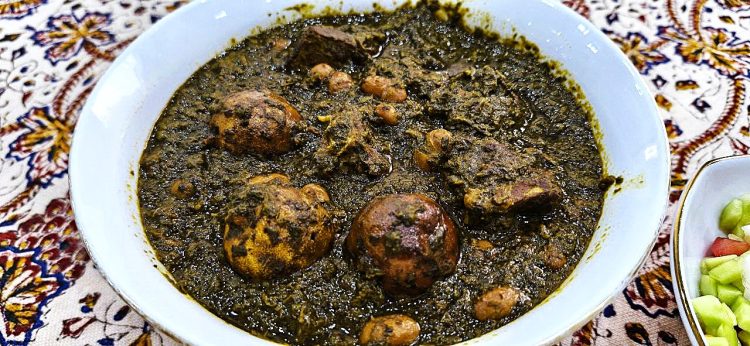
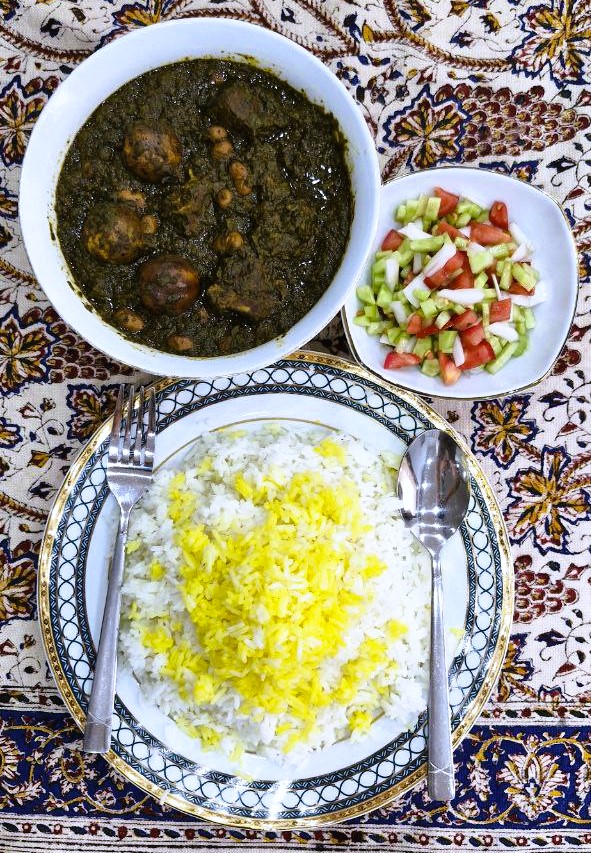


Pingback: Best Persian stews - Mesry Tasty
Pingback: Khoresh Gheymeh Recipe (Persian Lamb Stew with Yellow Split Peas) - Mesry Tasty
Pingback: Tahdig Recipe | The Crunchy Persian Treasure Everyone Fights Over - Mesry Tasty